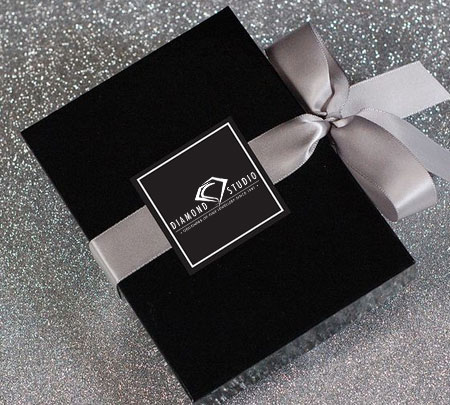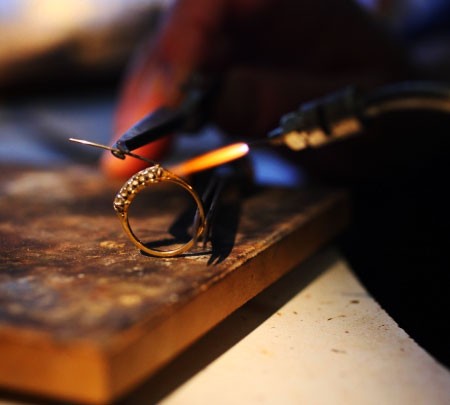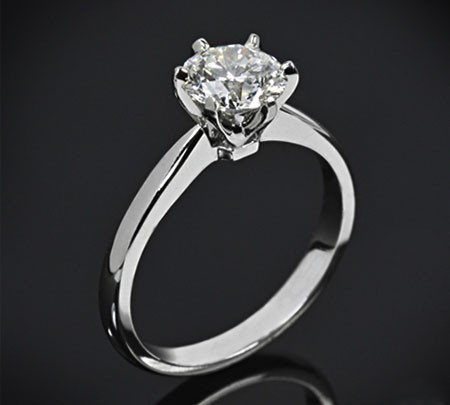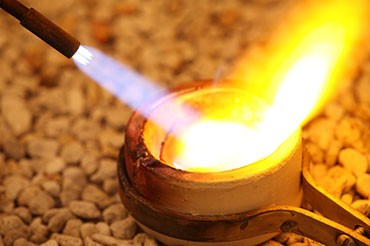Gold and platinum
Although “gold” tends to inspire the image of the traditional yellow kind, there are many different types, from rose to white. Alloys with different metals create the various “colours.”
“Gold jewellery” can be used to describe items containing varying levels of gold. The level impacts on value and strength, so make sure you know what you’re buying. These are some types and markings you may encounter:
Gold plated (GP): metal with a thin layer of gold on the surface, usually applied by electroplating.
Gold filled (GF): a thin outer layer of gold on a base metal such as iron, nickel or lead. This is created by a process called bonding, in which the gold layer is bonded to the other metal rather than simply plated over the top.
Rolled gold (RGP): this is made by the same process as gold filled jewellery, but with a thinner layer of gold.
White gold
Originally developed as a substitute for platinum, white gold is gold alloyed with at least one white metal. Its inherent colour is somewhat grey, so it’s often coated with rhodium to give it a brighter finish.
White gold is currently very popular, but jewellery made from it can have problems.
If
the gold is alloyed with a high-quality metal such as platinum or
palladium it will retain a good whiteness even when the rhodium wears
away. But if it’s a lower-quality nickel mix, it will need regular
re-plating to maintain the shine. It’s recommended that this is done
once a year, which represents a significant cost – $65 to $95 per
re-plating. Jewellers risk breaching the Fair Trading Act if they don’t
warn consumers about re-plating requirements before they buy.
Platinum
According to the JWNZ (Jewellers and Watchmakers New Zealand), “Platinum is the king of metals, because it is the toughest.”
Because of this strength, jewellery can be made from almost pure platinum.
Traditionally, platinum has been the most expensive of the metals, but the rocketing gold price has put gold ahead – on raw material at least, but working Platinum is much more demanding, so finished jewellery is still more expensive in this beautiful metal.
Metal purity
Most
precious metals are too soft in their pure form to make jewellery, so
they’re alloyed with other metals. Jewellery made of a precious metal
should be stamped to show its purity – either as carats or metric
fineness.
(Some countries use “karats” for metals and “carats” for
gems, but in New Zealand we don’t distinguish this way, using “carat”
interchangeably.)
Carats (ct) indicate the level of precious metal
in the alloy and are measured in units of 24. 24ct is 99+ percent pure,
whereas 14ct is 14 parts metal and 10 parts alloy, or 58.5 percent pure.
Metric
fineness indicates parts per thousand of pure metal in the alloy. For
example, 925 is the fineness of sterling silver, meaning it’s 92.5
percent silver and 7.5 percent copper.
Gem quality
When it
comes to gems, carats refer to weight rather than purity. 1.00ct of gem
weight equals 0.2 grams (about the weight of a paperclip).
A carat
is one of four factors (“the four Cs”) that determine the quality of a
gemstone. It’s possible for two gems of the same carat to differ in
value because of differences in the other “Cs”: colour, cut and clarity.
The
way a gem is cut draws the eye to the richness of its colour and
brilliance. A poor cut can lower a gem’s value. Clarity refers to the
presence – or absence – of flaws (inclusions) in a gem. Flawless gems
are extremely rare; even very expensive ones will often have some
inclusions.
Hallmarks
Unlike Britain and Denmark, for example, New Zealand doesn’t have a hallmarking system (the practice of putting a mark on items made of precious metals to confirm their quality is up to the legal standard). However, you should check antique jewellery for hallmarks, as much of it was imported from Britain – but be careful, as they can be faked.
Fake stones
Many in the
industry say the increase in jewellery sold online has led to big
problems for consumers inadvertently buying fake stones.
Jewellery
sold online has led to big problems for consumers inadvertently buying
fake stones. Jewellery sold online has led to big problems for consumers
inadvertently buying fake stones
Most gemstones are treated to some degree. But treatments have become increasingly sophisticated, to the point where it can take quite high tech equipment to detect. Low-grade gemstones can be clarified with these treatments. Some stones are filled with glass, which can leave them unstable. This may be discovered when a ring is taken to a jeweller to be reset and the stone cracks and melts under the heat of the torch.
There may be some tell-tale signs – the colour’s too good, or the stone’s too clear. But often no-one knows they’re fakes, even the sellers. If it seems too good to be true, it usually is… be careful.
Insurance
Precious jewellery is valuable and easy for thieves to transport – or for owners to lose!
A
common problem is that people assume jewellery is automatically covered
by their house and contents insurance. Policies often do cover such
items as “unspecified jewellery” or “personal effects”, but if the cover
is unspecified, it will have a limit – usually between $2000 and $3000.
Some policies have an aggregate limit in which maximum claims for
unspecified jewellery can be as much as $3000 per item and $15,000 in
total per event. But find out whether this is the case before such a
claim is necessary.
You’ll also need to prove ownership by providing original receipts, colour photographs or detailed descriptions. If you can’t prove you owned it in the first place, your claim may be declined.
Tip: If you have valuable jewellery, itemize each piece: photograph it, get a formal valuation and list it separately in your insurance policy. Keep receipts and valuations separate from your jewellery.
It’s also a good idea to have extra protection such as a safe and burglar alarms for valuable pieces. As well as keeping your jewellery secure, measures like this may lower your insurance premiums.
Valuations
The value of precious jewellery is subject to fluctuation along with currency exchange rates and the price of metals and precious stones. Because of this, some insurers require policy-holders get new valuations each year.
There are 2 main types of insurance values for jewellery: replacement and indemnity value.
Replacement value is the cost of repairing or replacing the item to an as-new condition. Insurers sometimes refer to this type of cover as “new for old”.
These valuations are often higher than the price you paid, and also higher than you would get if you sold the item. This is because they provide the insurance company with an outer limit of its exposure to risk – the maximum it could expect to pay for the raw materials and labour needed to make a replacement.
Indemnity value, also known as market value or present day value, is the cost of repairing or replacing an item so that you’re left with something of a similar age, quality and condition.
Valuers
There is no regulation for jewellery valuers, so technically anyone can set themselves up as one. However, insurance companies will increasingly only accept valuations from qualified gemologists and valuers. Diamond Studio utilizes the services of Gemlab Jewellery Valuers to provide independent valuation certificates for our clients.
Our advice
It’s best not to think of buying jewellery as an investment – you can’t count on it rising in value. Buy it for personal reasons rather than financial.
Make sure you know what you’re getting – buy from a reputable source and understand what the markings mean.
Be wary of buying expensive jewellery, particularly stones, online – you may not be covered by the Consumer Guarantees Act and could have difficulty contacting the trader if something goes wrong.
Retailers need to make sure consumers are informed about any requirements such as regular re-plating before they buy.
Look after your jewellery – keep it clean, get it checked, store it securely and get it insured.
Finally, choose to use a member of the Jewellers and Watchmakers of New Zealand (JWNZ) for peace of mind when it comes to spending your money.
With thanks to https://www.consumer.org.nz for the basis of this guide.





